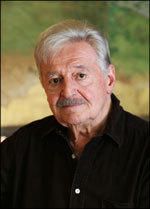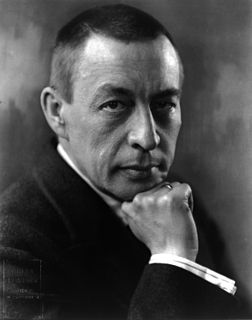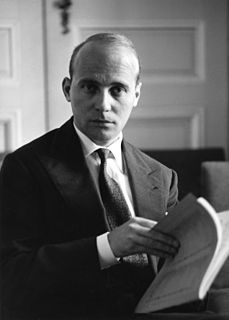
Memento Mori (1993) is a composition for orchestra by Peter Sculthorpe. The title refers to the medieval Christian idea of memento mori , and the piece itself makes frequent references to the plainchant setting of the Latin hymn "Dies irae". [1]

Memento Mori (1993) is a composition for orchestra by Peter Sculthorpe. The title refers to the medieval Christian idea of memento mori , and the piece itself makes frequent references to the plainchant setting of the Latin hymn "Dies irae". [1]
Laurie Strachan wrote in The Australian, when reviewing the piece on October 22, 1993, that "[t]he work was inspired by a visit to Easter Island, famous for its great stone heads, monuments that can be seen as both an example of the indomitable nature of the human spirit and as part of its great folly - for their making and transportation deforested and impoverished the island." [2] When composing, Memento Mori, Sculthorpe focused on the link between 'the personal notion of morality' and the 'extended environmental sense of fragility', using 'Easter Island as a parable for planet Earth and population growth'. [3] [4]

In the original programme notes, the composer described the way he conceived of the work:
It seems that on Easter Island, at the beginning of the seventeenth century, there was a population explosion. The inhabitants stripped the island of trees, causing soil erosion and depriving themselves of building materials for boats and housing. Retreating to caves, clans fought each other, and finally there was enslavement and cannibalization. By the time the first Europeans arrived, in 1722, the survivors had even forgotten the significance of the great stone heads that still stand there.
Easter Island is a memento mori (literally, "remember to die") for this planet. The concern of this work, therefore, is not with what happened to the inhabitants of Easter Island, but with what could happen to all of us, with what could happen to the human race.
— Peter Sculthorpe, [1]
The work has received mixed reviews. Joseph McLellan, writing in The Washington Post , stated that:
It is a piece imbued with a religious aura, rooted in a particular landscape - barren, mysterious Easter Island, with its enormous, brooding, enigmatic statues. And it is full of tunes, most notably the ancient plainchant Dies irae, which has been used by many classical composers but seldom with the blend of reverence and coloristic effectiveness Sculthorpe has achieved … It was marvelously effective music, innovative in sound but listener-friendly.
— Joseph McLellan, [2]
Laurie Strachan, writing in The Australian, was similarly positive, writing that Memento Mori was 'one of [Sculthorpe's] most immediately appealing scores.' [2] Strachan went on further to say that '[t]here are some hauntingly beautiful melodies and striking tonal contrasts. Some play is made of the plainchant Dies irae but this is not overdone and the whole thing ends on a note of quiet resolution that's absolutely right.’ [2]
Conversely, Andrew Clements, while reviewing a CD of Sculthorpe's work for The Guardian , said that the Memento Mori was "the most conventional and least effective piece on [the] disc". [5]
The music is scored for two flutes (flute 2 doubling piccolo), two clarinets, two oboes, two bassoons, four horns, four trumpets, two trombones, bass trombone, tuba, timpani, percussion (two players), and strings. [6]
Memento Mori is in one movement and last for approximately 14 minutes. [1] It is in common time and the tempo is lento. [7] The piece opens with an introduction, which them leads into two statements of the Dies irae plainchant, part of the Latin mass for the dead:
Following this, the music oscillates between the pitches of G and A-flat. The composer notes that this is because the astronomer Kepler believed those pitches to be the sound of the planet Earth. [1] Then there a further two statements of the Dies irae plainchant, by which the music reaches a solemn climax, followed by more somber music. [3]
The work was commissioned by the ABC for performance by West Australian Symphony Orchestra. [6] It was first performed by the West Australian Symphony Orchestra, with Jorge Mester conducting, on July 2, 1993, in the Perth Concert Hall. [6] [1] It has subsequently been performed several times, most recently by the Queensland Conservatorium Symphony Orchestra, with Peter Morris conducting, on March 27, 2015. [6]

"Dies irae" is a Latin sequence attributed to either Thomas of Celano of the Franciscans (1200–1265) or to Latino Malabranca Orsini, lector at the Dominican studium at Santa Sabina, the forerunner of the Pontifical University of Saint Thomas Aquinas in Rome. The sequence dates from the 13th century at the latest, though it is possible that it is much older, with some sources ascribing its origin to St. Gregory the Great, Bernard of Clairvaux (1090–1153), or Bonaventure (1221–1274).

The Rhapsody on a Theme of Paganini, Op. 43, is a concertante work written by Sergei Rachmaninoff for piano and orchestra, closely resembling a piano concerto, all in a single movement. Rachmaninoff wrote the work at his summer home, the Villa Senar in Switzerland, according to the score, from 3 July to 18 August 1934. Rachmaninoff himself, a noted performer of his own works, played the piano part at the piece's premiere on 7 November 1934, at the Lyric Opera House in Baltimore, Maryland, with the Philadelphia Orchestra conducted by Leopold Stokowski. Rachmaninoff, Stokowski, and the Philadelphia Orchestra made the first recording, on 24 December 1934, at RCA Victor's Trinity Church Studio in Camden, New Jersey. The English premiere on 7 March 1935 at Manchester Free Trade Hall also featured Rachmaninoff with The Hallé under Nikolai Malko.
Sir George William John Benjamin, CBE is an English composer of contemporary classical music. He is also a conductor, pianist and teacher. He is well known for operas Into the Little Hill (2006), Written on Skin (2009–2012) and Lessons in Love and Violence (2015–2017)—all with librettos by Martin Crimp. In 2019, critics at The Guardian ranked Written on Skin as the second best work of the 21st-century.

Peter Joshua Sculthorpe was an Australian composer. Much of his music resulted from an interest in the music of Australia's neighbours as well as from the impulse to bring together aspects of native Australian music with that of the heritage of the West. He was known primarily for his orchestral and chamber music, such as Kakadu (1988) and Earth Cry (1986), which evoke the sounds and feeling of the Australian bushland and outback. He also wrote 18 string quartets, using unusual timbral effects, works for piano, and two operas. He stated that he wanted his music to make people feel better and happier for having listened to it. He typically avoided the dense, atonal techniques of many of his contemporary composers. His work was often distinguished by its distinctive use of percussion.
Totentanz : Paraphrase on Dies irae, S.126, is the name of a work for solo piano and orchestra by Franz Liszt notable for being based on the Gregorian plainchant melody Dies irae as well as for stylistic innovations. It was first planned in 1838, completed and published in 1849, and revised in 1853 and 1859.
John Raymond Hopkins AM OBE was a British-born Australian conductor and administrator.

The Symphony No. 2 in E minor, Op. 27 by Russian composer Sergei Rachmaninoff was written from October 1906 to April 1907. The premiere was performed at the Mariinsky Theatre in Saint Petersburg on 26 January 1908, with the composer conducting. Its duration is approximately 60 minutes when performed uncut; cut performances can be as short as 35 minutes. The score is dedicated to Sergei Taneyev, a Russian composer, teacher, theorist, author, and pupil of Pyotr Ilyich Tchaikovsky. The piece remains one of the composer's most popular and best known compositions.

Russian Easter Festival Overture: Overture on Liturgical Themes, Op. 36, also known as the Great Russian Easter Overture, is a concert overture written by the Russian composer Nikolai Rimsky-Korsakov between August 1887 and April 1888. It was dedicated to the memories of Modest Mussorgsky and Alexander Borodin, two members of the group of composers known in English as "The Five". It is the last of what many call his three most exceptionally brilliant orchestral works, preceded by Capriccio Espagnol and Scheherazade. The work received its premiere at a Russian symphony concert in St. Petersburg on 15 December [O.S. 3 December] 1888.
Christopher Chapman Rouse III was an American composer. Though he wrote for various ensembles, Rouse is primarily known for his orchestral compositions, including a Requiem, a dozen concertos, and six symphonies. His work received numerous accolades, including the Kennedy Center Friedheim Award, the Grammy Award for Best Classical Contemporary Composition, and the Pulitzer Prize for Music. He also served as the composer-in-residence for the New York Philharmonic from 2012 to 2015.
Veni, Veni, Emmanuel is a concerto for percussion and orchestra by James MacMillan. MacMillan began composing it on the first Sunday of Advent 1991 and completed it on Easter Sunday 1992, dates that are significant to the work itself. The work was commissioned by Christian Salvesen PLC. It received its premiere on 10 August 1992 at the Royal Albert Hall, London, performed by Evelyn Glennie and the Scottish Chamber Orchestra under Jukka-Pekka Saraste. The work is in one movement, and lasts around 25 minutes. The music draws on the Advent plainchant of the same name, which appears in its full form only at the end.

The Symphonic Dances, Op. 45, is an orchestral suite in three movements. Completed in 1940, it is Sergei Rachmaninoff's last major composition.

Polish Requiem, also A Polish Requiem, is a large-scale requiem mass for soloists, mixed choir and orchestra by the Polish composer Krzysztof Penderecki. The Lacrimosa, dedicated to the trade union leader Lech Wałęsa, was written for the unveiling of a statue at the Gdańsk Shipyard to commemorate those killed in the Polish anti-government riots in 1970. He expanded the work into a requiem, writing other parts to honour different patriotic events over the next four years.

Brenton Thomas Broadstock is an Australian composer. He was appointed a Member of the Order of Australia on Australia Day in 2014 for "significant service to music as a composer, educator and mentor".

Hans Werner Henze composed the nine Sacred Concertos that comprise his Requiem over the course of three years from 1991 to 1993 on commissions from the London Sinfonietta, Suntory Corporation for the NHK Philharmonic, and Westdeutscher Rundfunk, Cologne. The first movement, Introitus: Requiem Aeternam was commissioned by the London Sinfonietta as part of a memorial concert for Artistic Director Michael Vyner who died on 20 October 1989. In addition to Henze, the London Sinfonietta also commissioned seven other prominent composers to write works in Vyner's memory to make up the program which was performed on the 6 May 1990.

Donald Henry Kay AM is an Australian classical composer.

Torsten Rasch is a German composer of contemporary classical music. He lives in Berlin, but has found moderate success in the UK.
Clare Maclean is a New Zealand composer. She received her formative musical training under Gillian Bibby at the Wellington Polytechnic. She then moved to Australia, where she studied composition in Sydney with Peter Sculthorpe. Singing with the Sydney University Chamber Choir under the direction of Nicholas Routley introduced her to the intricate Renaissance polyphony that affected her early compositions.
Rites of Passage is a music theatre work written by the Australian composer Peter Sculthorpe in 1972–73. It is often categorised as an opera, but it does not conform to the traditional concept of opera. It is written for dancers depicting the ritual of initiation of the Aranda people, an indigenous tribe; double SATB chorus singing words from Boethius and others; three percussionists, two tubas, piano (echoed), six cellos and four double basses; but no parts for individual singers. Sculthorpe drew on the approach espoused by Jean-Baptiste Lully, in which dance, drama and music are not separated.
The Symphony No. 5, Washington Mosaics, Op. 57, is an orchestral composition by the Finnish composer Aulis Sallinen, who wrote the piece from 1984–85, revising the finale in 1987. The National Symphony Orchestra, the commissioning institution, premiered the work in 10 October 1985 at the Kennedy Center in Washington, D.C., under the direction of its music director, Mstislav Rostropovich.
The Trombone Concerto is a composition for trombone and orchestra written by the Scottish composer James MacMillan. The work was commissioned by the Royal Concertgebouw Orchestra for their principal trombonist Jörgen van Rijen and co-commissioned by a consortium of orchestras comprising the Dallas Symphony Orchestra, Royal Flemish Philharmonic Orchestra, the Orchestre de la Suisse Romande, the Oulu Symphony Orchestra, and the Philharmonisches Orchester des Staatstheaters Cottbus. It was first performed by Jörgen van Rijen and the Royal Concertgebouw Orchestra under the direction of Iván Fischer at the Concertgebouw, Amsterdam, on 20 April 2017. The piece is dedicated to Jörgen van Rijen and in memory of Sara Maria MacMillan, the composer's granddaughter, who died shortly before its composition.